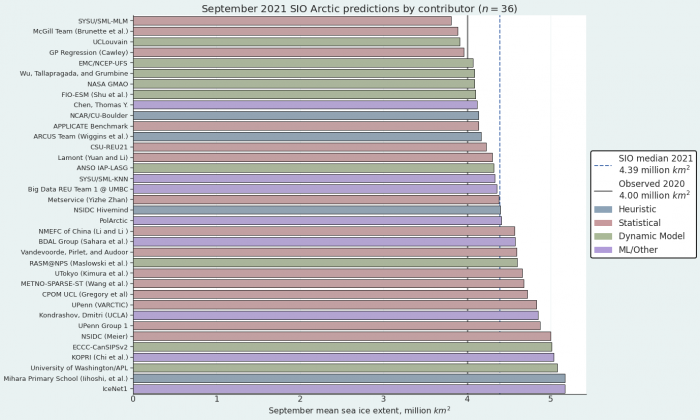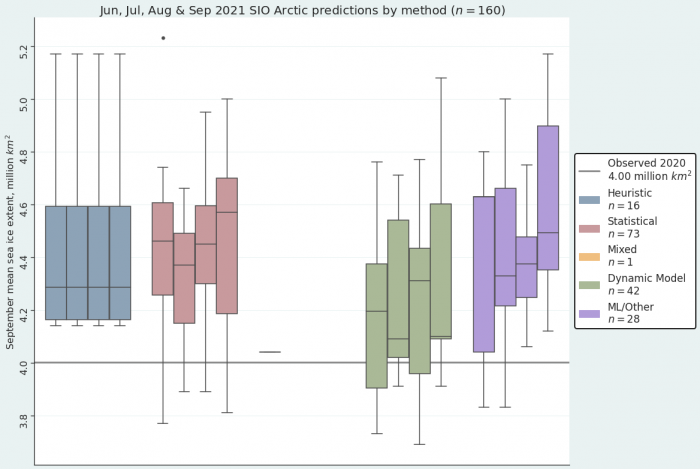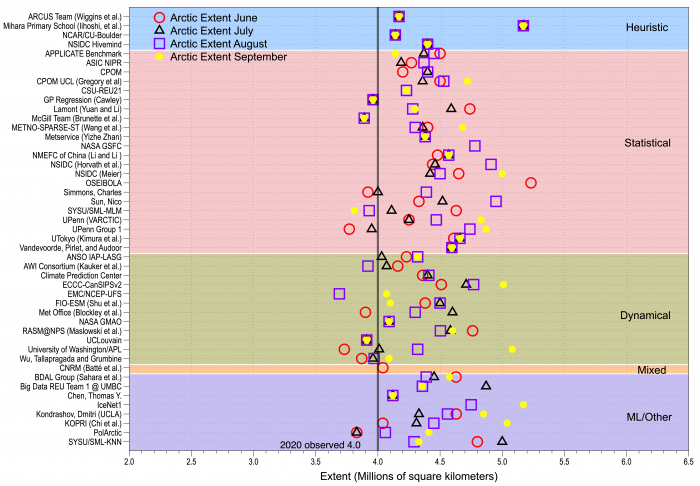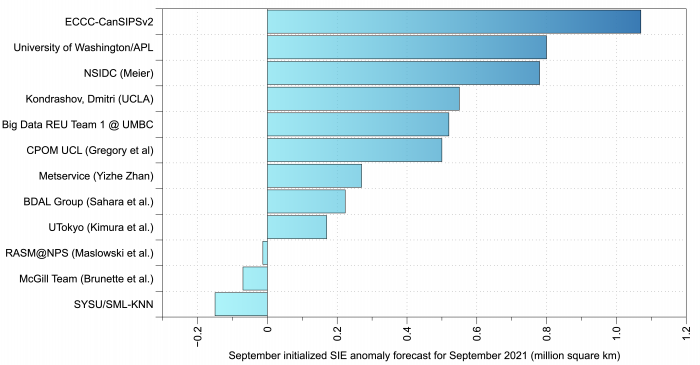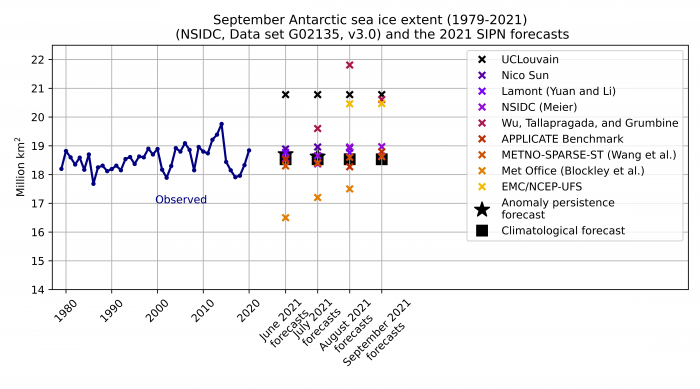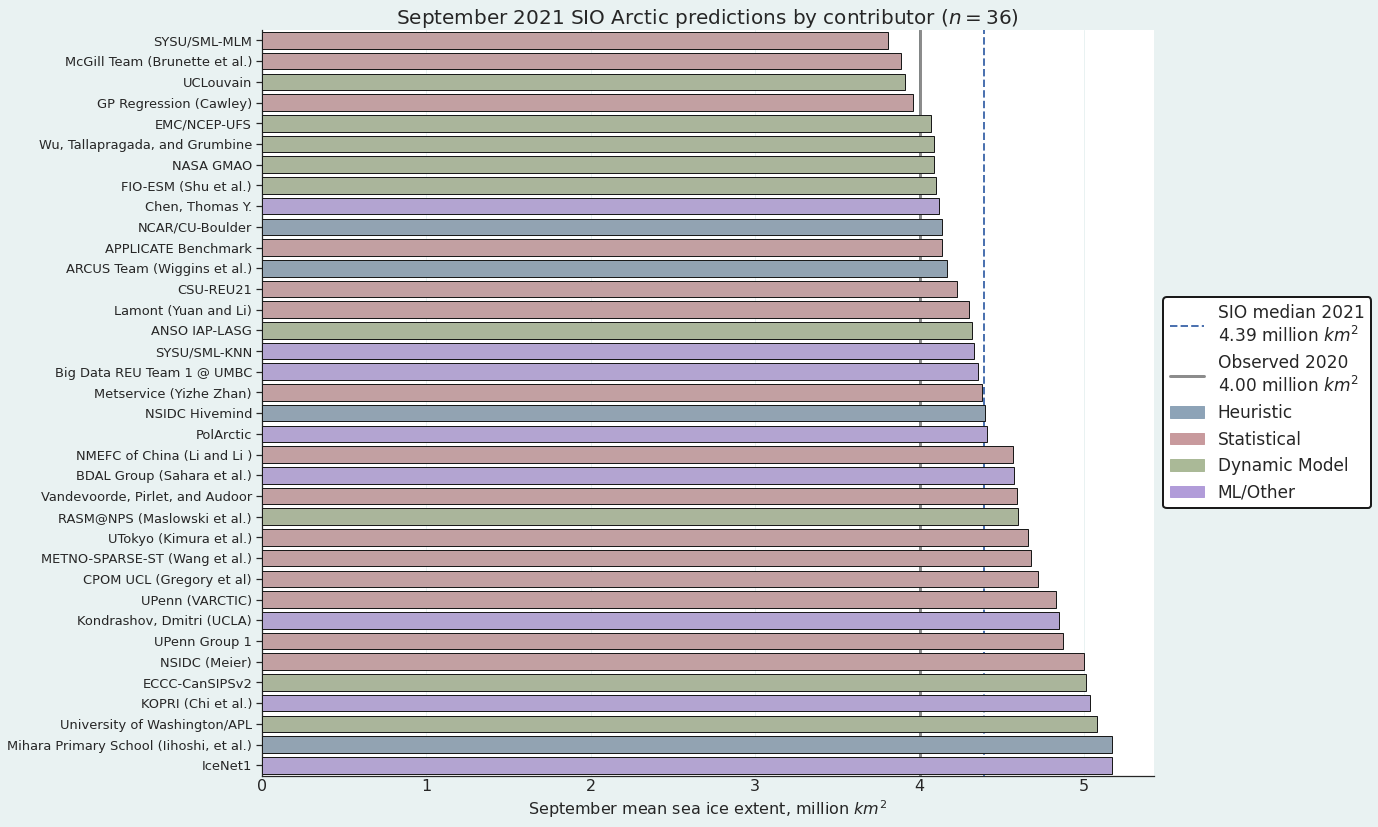Outlook Report
Executive Summary
This September Sea Ice Outlook (SIO) report is a new addition to the SIO season. It has been created in response to participant suggestions during the 2021 January SIO Contributors Forum to solicit forecasts initialized in late August or early September for September mean Arctic sea-ice extent. The September SIO report provides a brief summary of the forecasts. The more comprehensive, full post-season report will be published in spring 2022. We are pleased to have received 20 new forecasts for the September 2021 SIO for the pan-Arctic, seven for Alaska, and seven for the Antarctic. In addition, we received 11 submissions for the pan-Arctic sea-ice extent anomalies. Spatial forecasts were not requested but those that were received for September via the SIPN2 portal will be discussed in the post-season report. The SIPN2 Project Team will host a post-season webinar and discussion on Monday, 11 October that will provide an overview of observed conditions during the 2021 Arctic sea-ice retreat season, a summary of how the SIO contributor outlooks performed in comparison to the observed September monthly mean extent, and an overview of lessons learned from the SIPN2 project. This webinar will be in lieu of a written interim post-season report. The most recent observational conditions are not presented here for brevity and will be discussed at the October webinar. The median Arctic September Outlook is 4.39 million square kilometers, equal to the August median and higher than the median of the June and July forecasts for 2021. It is noteworthy that the spread in the forecasts increased for the September SIO compared to August 2021. The mean of the pan-Arctic anomaly forecast was largest for the September 2021 SIO with a mean of 0.39 million square kilometers, larger than forecast earlier in the summer of 2021 (June=+0.15, July=+0.21, and August=+0.26). For the Alaska region, the September 2021 SIO median forecast was 0.50 million square kilometers based on seven contributions. The 12 September contributions of September mean sea-ice extent anomaly range from -0.15 to +1.07 million square kilometers, with nine forecasts above and four below the contributors' baseline. For the Antarctic forecast, the pattern that has been observed in the previous round of forecasts remains, with a cluster of forecasts that use statistical approaches and several forecasts based on dynamical modeling.
This September Sea Ice Outlook report was developed by lead author Uma Bhatt, University of Alaska Fairbanks (Executive Summary, Overview, Discussions of Arctic Regional Sea-Ice Extent, and Arctic Sea-Ice Extent Anomalies) with contributions from François Massonnet, Université catholique de Louvain (Antarctic Contributions Discussion); Matthew Fisher, NSIDC (figures); Betsy Turner-Bogren and Lisa Sheffield Guy, ARCUS (report coordination and editing); and the rest of the SIPN2 Project Team.
Note: The Sea Ice Outlook provides an open process for those who are interested in Arctic sea-ice, to share predictions and ideas; the Outlook is not an operational forecast.
See: September Call for Contributions.
Editor's Note: The hyperlinked captions in several figures below provide access to a high-resolution version of the image.
Overview
The September Outlook is based on a total of 36 forecasts (Figure 1), of which 20 are new September submissions and 16 outlooks are repeated from prior months per contributor request and/or permission (For details, see: Contributor Full Report PDFs below). The median September Outlook value for the September 2021 sea-ice extent is 4.39 million square kilometers, with quartile values of 4.1 and 4.7 million square kilometers. Of the 36 contributions in September 2021, nine are based on dynamical models, 15 are based on statistical methods, four are based on heuristic approaches (qualitative analyses), and eight used machine learning-based or other (ML/Other) methods. The median of SIO contributor forecasts increased from June to September: 4.37 million square kilometers in June, 4.36 million square kilometers in July, 4.39 million square kilometers in August, and 4.39 million square kilometers in September. For reference, the preliminary observed average 1–19 September 2021 Arctic sea-ice extent is 5.45 million square kilometers.
The forecast spread shown for each method (Figure 2) displays an increase for the ML/Other, statistical, and dynamical models in September compared to August. The median values vary among methods used in the September 2021 Outlook and are (in million square kilometers for all): 4.57 for the statistical, 4.1 for the dynamical, 4.28 for the heuristic, and 4.49 for ML/Other.
Figure 3 compiles each group's 2021 submissions from June through September with the 2020 mean September Arctic ice extent shown for reference. The majority of the individual forecasts for all months fell above the observed 2020 September mean sea-ice extent, and all but four (only one was a new September forecast) of the September 2021 forecasts were above the 2020 observed value of 4.0 million square kilometers.
Alaska Regional Sea-Ice Extent
For the Alaska region, the September 2021 SIO median forecast was 0.50 million square kilometers based on seven contributions. This is lower than the June through August median forecasts of 0.67, 0.51, and 0.62 million square kilometers, respectively. The three dynamical model predictions ranged from 0.41 to 0.64 million square kilometers with a mean of 0.52 square kilometers (Figure 4). The three statistical model predictions ranged from 0.31 to 0.64 million square kilometers and had a mean of 0.48 million square kilometers. One machine learning-based prediction was submitted with a prediction of 0.81 million square kilometers. The September spread (Figure 5) is larger in the statistical models in the September Outlook compared to the August 2021 SIO. In contrast, the spread is larger in the August 2021 SIO compared to September for the dynamical models. The medians of the statistical and dynamical models decreased between June and September SIOs. The ML/Other forecast 0.62 million square kilometers for the August SIO and increased to 0.81 million square kilometers for the September SIO. For reference, the preliminary observed average 1–19 September 2021 sea-ice extent in the Beaufort and Chukchi seas is 0.83 million square kilometers.
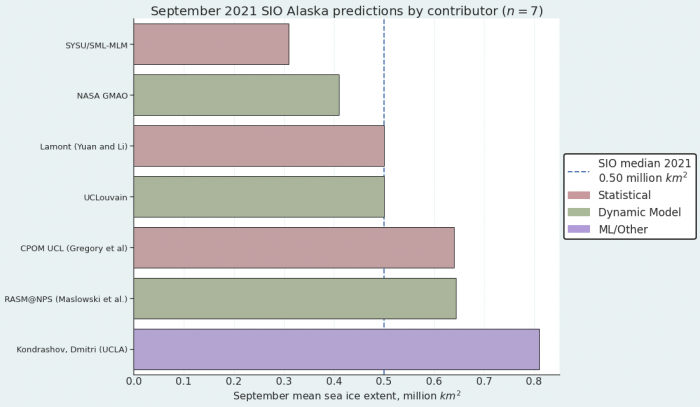
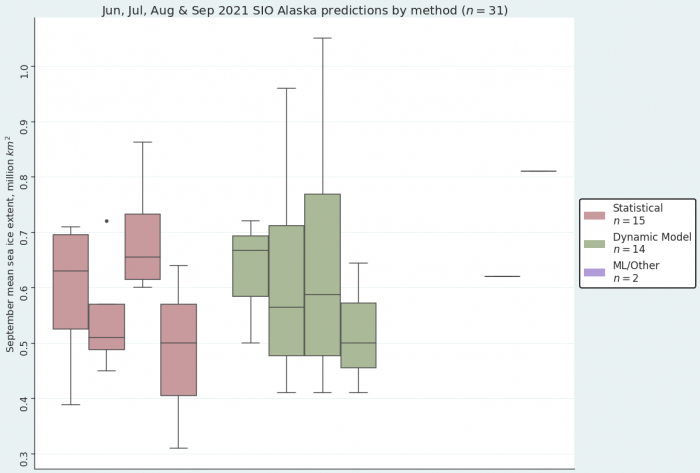
Arctic Sea Ice Extent Anomalies
The pan-Arctic sea-ice extent anomaly is the departure of the contributors' September extent Outlook relative to the contributors' baseline trend. The 12 September contributions of September mean sea-ice extent anomaly range from -0.15 to +1.07 million square kilometers, with nine forecasts above and three below the contributors' baseline (Figure 6). The September SIO anomaly forecast has a standard deviation of 0.38 million square kilometers, which can be contrasted for small spreads in earlier forecasts for the 2021 SIO reports (i.e., the standard deviation in August was 0.25, July was 0.27, and June was 0.29 million square kilometers). The mean of the anomaly forecasts increased with each forecast of the summer 2021 SIO season (June=+0.15, July=+0.21, August=+0.26, and September=+0.39).
Antarctic Contributions
For this new round of September-based outlooks, six updates were provided from the previous outlook (a seventh outlook uses the values of June). The pattern that has been observed in the previous round of forecasts remains, with a cluster of forecasts that use statistical approaches and several forecasts based on dynamical modeling. Because of the short lead time, it is likely that the actual September mean sea-ice extent will be closer to the mean of the statistical group than of the mean of the other group.
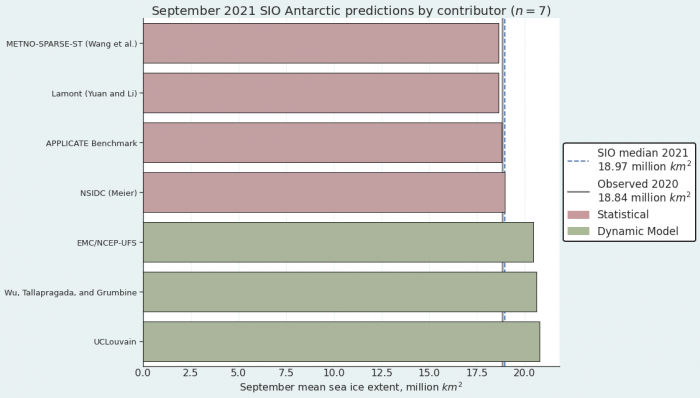
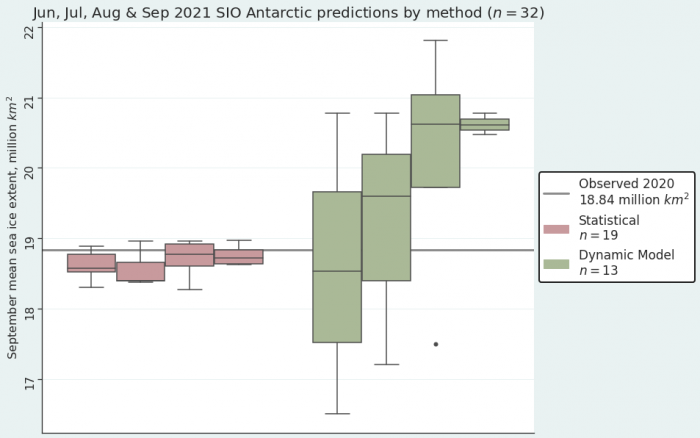
Contributor Full Report PDFs
This report was developed by the SIPN2 Leadership Team
Report Lead
Uma Bhatt, University of Alaska Fairbanks
Additional Contributor:
Matthew Fisher, Cooperative Institute for Research in Environmental Sciences at the University of Colorado Boulder, NSIDC
Editors:
Betsy Turner-Bogren, ARCUS
Lisa Sheffield Guy, ARCUS
Suggested Citation:
Bhatt, U.S., P. Bieniek, E. Blanchard-Wrigglesworth, H. Eicken, M. Fisher, L. C. Hamilton, J. Little, F. Massonnet, W. Meier, J.E. Overland, M. Serreze, M. Steele, J. Stroeve, R. Thoman, J. Walsh, M. Wang, and H. V. Wiggins. Editors: Turner-Bogren, B. and L. Sheffield Guy. September 2021. "Sea Ice Outlook: 2021 September Report." Published online at: https://www.arcus.org/sipn/sea-ice-outlook/2021/september
This Sea Ice Outlook Report is a product of the Sea Ice Prediction Network–Phase 2 (SIPN2), which is supported in part by the National Science Foundation under Grant No. OPP-1748308. Any opinions, findings, and conclusions or recommendations expressed in this material are those of the author(s) and do not necessarily reflect the views of the National Science Foundation.


